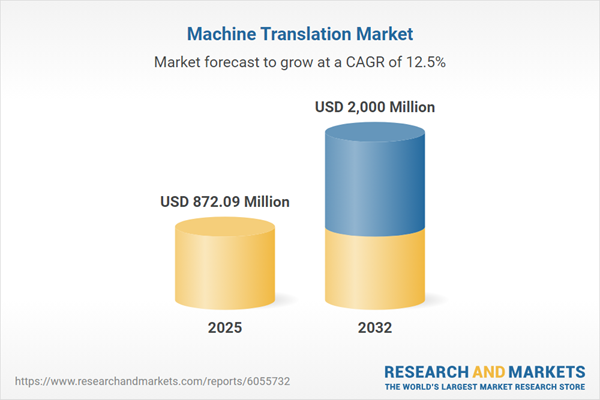Speak directly to the analyst to clarify any post sales queries you may have.
Machine translation technology is rapidly transforming cross-border business communications as enterprises prioritize operational agility and customer-centric solutions tailored to global markets. Advanced AI-driven translation solutions are increasingly pivotal for senior decision-makers navigating strategic expansion and evolving compliance requirements.
Market Snapshot: Machine Translation Market Size and Growth
The machine translation market grew from USD 779.77 million in 2024 to USD 872.09 million in 2025 and is projected to expand at a CAGR of 12.53%, reaching USD 2.00 billion by 2032. This growth is propelled by continuous innovation in neural networks, enhanced AI capabilities, and broad enterprise adoption. Organizations increasingly require real-time multilingual content solutions to support international business, compliance, and customer engagement initiatives.
Scope & Segmentation
This report delivers a comprehensive analysis of the machine translation market by technology, deployment, enterprise segment, end use, and global geography. Market segmentation examines industry-specific applications and technology adoption trends at scale.
- Offering: Services; Software
- Type: Neural Machine Translation (NMT); Rules-Based Machine Translation (RBMT); Statistical Machine Translation (SMT)
- Deployment Mode: On-cloud; On-premise
- Enterprise Size: Large Enterprises; Small & Medium-sized Enterprises
- End-User: Aerospace & Defense; Automotive & Transportation; BFSI; Consumer Electronics; Energy; Healthcare & Medical Devices; IT & Telecommunications; Manufacturing
- Region: Americas, including North America (United States, Canada, Mexico) and Latin America (Brazil, Argentina, Chile, Colombia, Peru); Europe, Middle East & Africa, with key markets such as United Kingdom, Germany, France, Russia, Italy, Spain, Netherlands, Sweden, Poland, Switzerland, the Middle East markets (United Arab Emirates, Saudi Arabia, Qatar, Turkey, Israel), and Africa (South Africa, Nigeria, Egypt, Kenya); Asia-Pacific, including China, India, Japan, Australia, South Korea, Indonesia, Thailand, Malaysia, Singapore, Taiwan
- Leading Companies: AISA Digital, Alibaba Cloud International, Amazon Web Services, AppTek.ai, DeepL SE, Google LLC, IBM Corporation, LILT Inc., Lionbridge Technologies, MarsTranslation, Meta Platforms, Microsoft Corporation, Pangeanic, PROMT, Reverso, RWS Holdings PLC, SAP SE, Smartling, SYSTRAN, Tencent Cloud, TextUnited, TransPerfect Global, Unbabel, XL8 Inc., YANDEX LLC
Key Takeaways for Senior Decision-Makers
- Innovations in machine translation are now integral to digital transformation, underpinning scalable multilingual operations across customer experience, supply chain, and regulatory frameworks.
- Converging advances in AI, neural networks, and adaptive translation engines allow for nuanced, context-aware language solutions that meet diverse business and industry requirements.
- Adoption dynamics differ by sector, with compliance-heavy industries and fast-moving technology segments driving demand for secure, customizable deployments and seamless software integration.
- Regional infrastructure maturity, localization demands, and regulatory complexity shape technology preferences and provider partnerships in each major market.
- Vendor selection increasingly depends on the alignment of technology roadmaps with operational needs, including explainability, auditability, and data governance.
Impact of 2025 United States Tariff Policies
Recent changes to U.S. tariffs have introduced new cost considerations for translation platforms and hardware procurement. Senior leaders are adjusting vendor strategies, revising cost models, and expanding local partnerships to safeguard supply resilience and maintain control over operating margins.
Methodology & Data Sources
This analysis integrates systematic reviews of technical literature with direct expert interviews across sectors. Survey data from active users complements qualitative insights. Rigorous triangulation and data validation procedures ensure comprehensive coverage and credible findings for strategic planning.
Why This Report Matters
- Enables executives to benchmark technology options and cost structures for successful machine translation investments in regulated and dynamic markets.
- Offers actionable perspectives on aligning language solutions with business strategy, compliance, and regional needs for measurable impact.
Conclusion
The future of machine translation hinges on tailored technology integration, compliance readiness, and adaptive vendor engagement. Organizations that act on these insights will strengthen global communications, innovation, and competitive positioning as digital transformation accelerates.
Table of Contents
3. Executive Summary
4. Market Overview
7. Cumulative Impact of Artificial Intelligence 2025
Companies Mentioned
The companies profiled in this Machine Translation market report include:- AISA Digital
- Alibaba Cloud International
- Amazon Web Services, Inc.
- AppTek.ai
- DeepL SE
- Google LLC
- IBM Corporation
- LILT Inc.
- Lionbridge Technologies, LLC.
- MarsTranslation
- Meta Platforms Inc.
- Microsoft Corporation
- Pangeanic
- PROMT
- Reverso
- RWS Holdings PLC
- SAP SE
- Smartling, Inc.
- SYSTRAN
- Tencent Cloud
- TextUnited GmbH
- TransPerfect Global, Inc.
- Unbabel Inc.
- XL8 Inc.
- YANDEX LLC
Table Information
| Report Attribute | Details |
|---|---|
| No. of Pages | 190 |
| Published | November 2025 |
| Forecast Period | 2025 - 2032 |
| Estimated Market Value ( USD | $ 872.09 Million |
| Forecasted Market Value ( USD | $ 2000 Million |
| Compound Annual Growth Rate | 12.5% |
| Regions Covered | Global |
| No. of Companies Mentioned | 26 |









